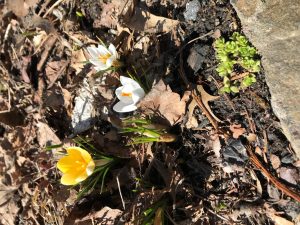
Crocuses, by Kirsten Lindquist
We all know it by different sounds, smells, colors and ways. For me, it’s the warm, ember-y smell of pine needles hit by the first long afternoon of warm sun. It’s in the sudden conk-la-ree of Red-winged Blackbirds trickling out amongst the reeds and cattails, right when you’d just about forgotten they exist. It’s in the thunk of a baseball meeting the mitts of kids playing catch or laughing in the street—out of the blue, heedlessly shaking off the habit of indoor winter evenings in a day. The light stretches longer, more richly over their heads in the afterschool hours. Even the soft, dank and rich scent of soggy earth underfoot hits me like cold Plum Island surf: spring is upon us.
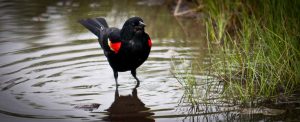
Red-winged Blackbird, by Jude Griffin
Spring signs conjure up more than anticipation of summer days in my mind. They strike a deeper chord. For me, these little changes call the soul out to play. They call for barefooted tag and swing-jumping after dinner, for finding your first caterpillar, and foraging for those dandelions that make the best secret 6-year-old potions when mixed with dirt and water.
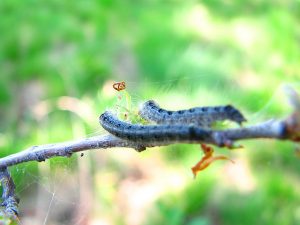
Tent caterpillars weaving their tent, by Jude Griffin
In the words of the sage Rachel Carson, “there is something infinitely healing in the repeated refrains of nature – the assurance that dawn comes after night, and spring after winter…those who dwell, as scientists or laypeople, among the beauties and mysteries of the earth, are never alone or weary of life.” But all too often, particularly as adults, it can be hard to eke out to time to visit the local park. These days, I’m most likely to sense the arrival of spring in snippets between errands, tasks at work and trips to the laundromat. Yet, I’m quite sure I’d not notice the newly-returned birds or the scent of pine needles if no one took me (or sent me) outside as a kid.
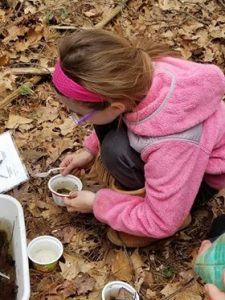
Checking out pond creatures, by Thaiadora Thaia Dorow
Kids these days are heavily scheduled too. Many don’t have a yard or park nearby to explore. Their recesses are cut short in favor of more academics. Often, all the adults in their home have jobs, and there isn’t much time to go out. The more children I get to know as an educator, the more I worry that children won’t get the same chance to grow nature roots like I enjoyed years ago, those same roots I depend on now as a source of energy and, as Carson wrote, “assurance.”
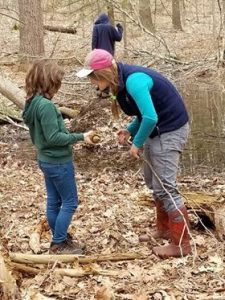
Inspecting for worm tunnels in branch, by Thaiadora Thaia Dorow
One thing I hear from adults again and again—from urban areas like Reno or Cambridge, to our suburban Newburyport— is: “I have no idea how to teach my kids about nature. What do I know about plants, or where to start? I’m actually kind of uncomfortable around dirt or bugs.” And that response makes complete sense. But, luckily, it is far easier to overcome those feelings than short recesses policies or hectic schedules. Whether you yourself are that adult wrestling with what to do outside, or know some, I want to share some of the easiest things to do with kids outside that I’ve tried out, in honor of spring and kids. None of it requires equipment, nor a science background, and just about all of it can be adapted to a big forest or to a little urban pocket park.
- Roll over some logs, leaf litter or stones. What can you find crawling around under there?
- Look for any evidence of animals. Little spots where leaves or grass has been dug up (like the size of a couple quarters) may be where a squirrel’s been scratching around for an acorn it hid last fall, or maybe it was a deer scrounging with its pointy hoof. Spring mud is perfect for finding tracks, as well as for making a mess! Sandy baseball diamonds are a great place to look for tracks, too.
- Use more than your eyes. Spring is full of new smells and an uptick of sounds. Close your eyes: how many sounds can you hear in 10 seconds? How many new textures can you feel that you missed during the winter?
- Go on a color hunt. Can you find something purple now that the snow’s melted? How about red or green? You may surprise yourself! Rinsed out yogurt cups are great for collecting interesting little leaves, stones or treasures from the ground. No need for fancy collecting cases.
- Visit a tree, then visit it again next week, and the next. Trees and plants are waking up, starting with the bumps on their branches, called buds. How much does your special tree change from week to week? If you’re lucky, you might spy a tree’s very first baby leaves of spring! Don’t worry too much about knowing which tree is which to start off.
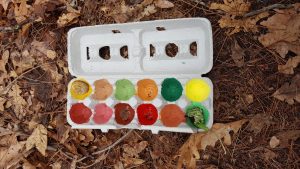
Egg carton customized for color hunt, by Lisa Hutchings
The kid in your life might not thank you now. They may even skeptically give you a look of, “You want me to bundle up to go out and touch mud?!” I’m sure I whined a bit when I was told to turn off the cartoons and get my rear-end outside. But, I have a strong hunch that someday when they’re 30 and hustling to the train station or grocery store like me, and light up at the fleeting sight of the first spring flower or bird call of spring, they’ll be silently thanking you.
Until then: thank you for all you do to connect your kids with our amazing world.
Kirsten Lindquist
Camp Director and Teacher-Naturalist
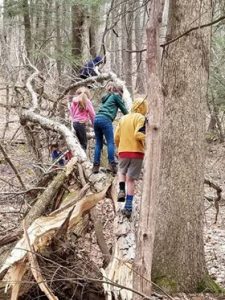
Treewalkers, by Thaiadora Thaia Dorow

